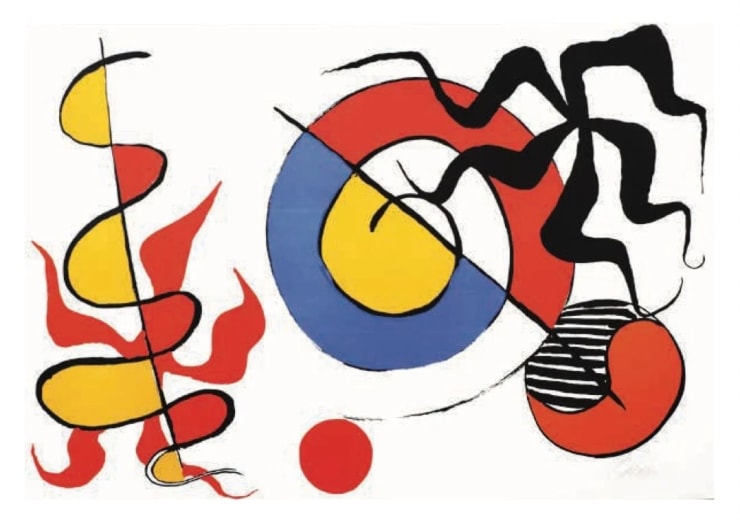Alexander Calder
The next step in sculpture is motion.
– Alexander Calder
Alexander Calder was an American artist who turned his line drawings into mobiles - kinetic sculptures powered by motors or air currents.
Alexander Calder was born in 1989 in Lawton, Pennsylvania. He came from a family of sculptors. His paternal grandfather emigrated from Scotland and is best known for the giant statue of William Penn on Philadelphia City Hall's tower. Calder’s father was also a sculptor, his mother a portrait artist who studied at the Académie Julian and the Sorbonne in Paris.
During his childhood, the family moved from California to New York several times. During each move the family set up a studio in the basement of their homes for the young Calder, who crafted jewelry, animal figures and game boards from found wood and metal. His hobby led him, not to art, but to mechanical engineering and applied kinetics, which he studied at Stevens Institute of Technology in Hoboken, New Jersey from 1915 to 1919.
While working at a series of jobs after graduation, including automotive engineer and hydraulics engineer, Calder took drawing classes at the 42nd Street New York Public School and at the Art Students League. He worked as an illustrator for the National Police Gazette and was sent to illustrate acts at the Ringling Brothers and Barnum & Bailey Circus.
In 1926, after his paintings were shown at The Artists' Gallery in New York he moved to Paris, where he began to make the moving figures that became Calder’s Circus.He also made jewelry from wire and began to use his line drawings as basis for wire sculptures. He met Joan Miro in Paris. Miro became a close friend and important influence.
It was a visit, in 1930, to the studio of Piet Mondrian that changed the way in which Calder fabricated his work. Seeing the color and forms that Mondrian created inspired Calder to create works that moved through space. He was successful at producing kinetic sculptures that were truly revolutionary. His initial works were mechanized, subsequent works relied on the movement of air. They were exhibited in Paris in 1931. Marcel Duchamp called them mobiles. Calder also created stabiles - sculptures that were fabricated from varied pieces that fit together to create movement.
After having great success in Paris, Calder moved back to the U.S. in 1933. He had a large studio in his home in Connecticut, where he created large mobiles and public sculptures. In 1939, the Museum of Modern Art (MoMA) commissioned Calder to create the large mobile, Lobster Trap and Fish Tail. In 1943, Calder became the youngest artist ever to be given a retrospective at MoMA. In 1946, the Galerie Louis Carre organized a retrospective of his work, accompanied by a catalog essay written by Jean-Paul Sartre.
In 1962, Calder built a studio in Sache, France, where he created some of his largest sculptures. Throughout his lifetime, he continued to make jewelry, paintings, fine art prints and tapestries. The Calder Circus inspired younger artists to incorporate their works into performance art. Calder had many international commissions and, in 1969, created the first public artwork funded by the National Endowment for the Arts.
Calder married Louisa James in 1931. The couple had two daughters.
Alexander Calder died unexpectedly in New York, in November 1976, of a heart attack, shortly after the opening of a major retrospective of his work at the Whitney Museum.
The Whitney has the largest collection of his works. Calder’s works are also in the permanent collections of MoMA, the National Gallery in Washington, D.C., the Centre Georges Pompidou in Paris, the Museo Nacional Centro de Arte Reina Sofía in Madrid and in other public venues around the world.
-

Calder Gardens Opens in Philadelphia
Robert Rauschenberg's Photography and Printmaking Celebrated September 25, 2025Calder Gardens in Philadelphia opened to the public on Sunday, September 21st. The building and gardens were designed by Swiss architect Jaques Herzog and Dutch...Read more -

On the Surface: Alexander Calder, Carmen Herrera, Polly Apfelbaum
Alex Katz: On View in Naples, Fl, Seattle and Paris January 29, 2025A concert of flat colored shapes can reference a riot of associations, humidities, memories of rooms, textiles, the silhouettes of flowers and birds, and the...Read more -

Matisse and More at the Expanded AGB Museum in Lakeland
Alexander Calder: Solid Gold January 22, 2025What I dream of is an art of balance, of purity and serenity, devoid of troubling or depressing subject-matter, an art which could be for...Read more -

Featured & Favorite Artists at VFA
September 3, 2024This past weekend was an exciting one in New York for art enthusiasts. Art on Paper 2024 , was held during Armory Art Week, celebrating...Read more -

VFA at the Hamptons Fine Art Fair 2024
July 11-14, 2024 July 2, 2024We hope you will join us at the Hamptons Fine Art Fair which runs from July 11-14, 2024. The fair, now in its 18th year,...Read more







